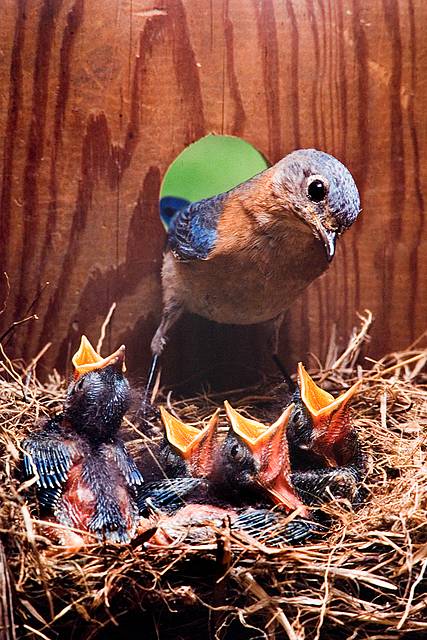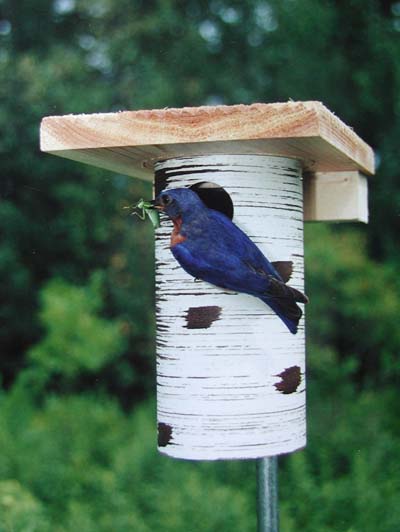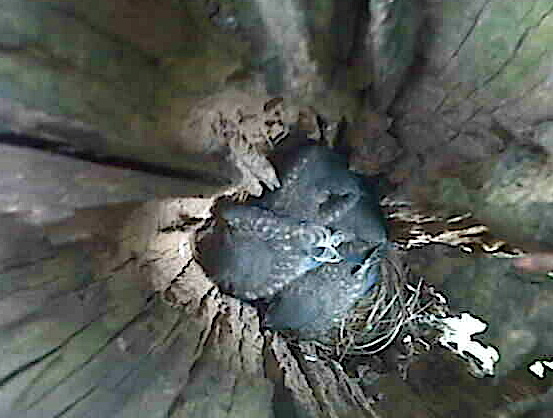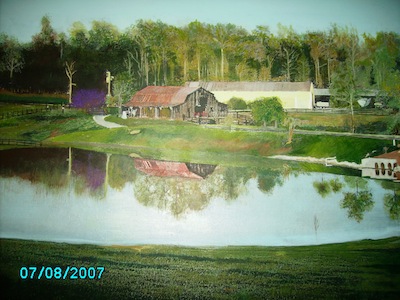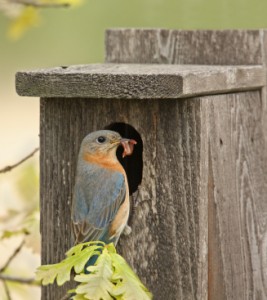-
Happy Father’s Day from Inside the Blue Bird Houses!
Many males in the winged world also labor in raising their families, so today we salute all of the hard working dads who help raise their kids!
A typical view inside blue bird houses, dad keeps a watchful eye on nestlings, while taking turns with mom bringing food to the babies.
The digs: A male bird’s skill at nest building is a sign of his suitability as a mate; he invests huge effort in the task. Males will build multiple nests to attract females, they’ll continue to build new nests until a female is happy with the construction and chooses one.
The food: Many male birds help raise their families, bringing food home to the babies. Sometimes they even have to incubate the eggs alone or take turns with the female. Male bald eagles, for example, take turns sitting on the eggs as well as bring food home to the young.
Protection: In species where both parents care for the young, the male often gathers food while the female spends more time brooding, keeping the baby birds warm, sheltered and safe from predators.
– Western Bluebirds usually breed in monogamous pairs. By the end of breeding season, most daughters disperse; most sons and the occasional daughter remain with their family for winter. In spring, the yearlings go off and nest on their own, but sometimes one or more sons stay to help their parents. Sometimes a bluebird with his own mate will help at his parents’ nest, while also feeding his own young next door. Source citation: The Cornell Lab of Ornithology
Happy Father’s Day to All~We salute your dedication to family!
-
blue bird houses with no roof!
We have a gazillion birds around the farm in North Georgia, a bald eagle was even spotted last year. A loud ruckus with crows dive-bombing it in order to block the eagles’ access to their nest. Unfortunately much of the population is house sparrows, who compete (fiercely) with native songbirds for nesting cavities.
You won’t find any blue bird birdhouses around the farm, or any birdhouses for that matter, but there’s certainly no shortage of nest sites and activity! Between the swallows and house sparrows around the three barns, and mockingbirds’ thick-stick nests in the crepe myrtles out front, that leaves about 400 acres of pure, natural habitat. Oh, and the heron, he loves to fly out of the ditch when folks are trail riding in the back. It spooks the horses every time… and he knows this (little fart!) A person could literally get a great start their bird list right here!
With some of the old wooden fencing still intact, the posts have deteriorated over time, and these bluebird chicks seem perfectly at home in one of those posts. If you catch the angle of that photo, you can see it was taken from above… No roof! What if it rains, and what about storms? We were like nervous mothers with concern for the babies. But a moms’ instinct is usually right on… four nestlings, and four successful fledges! You know, it did rain and it did storm on those babies, so I guess natural bird houses with no roof work too!
But I still wouldn’t recommend it!
It really wouldn’t behoove any of the birds to install nest boxes due to the sheer numbers of house sparrows on the property. There would be more fatalities than fledges as far as bluebirds, and we don’t need to encourage the house sparrows! In most of suburbia there is indeed a shortage of natural nest cavities. No rotted fence posts, very few dead trees, and less of the mature (we’re talking like one hundred year old) trees. Birdhouses really do help cavity-dwellers thrive and flourish. Are there some do’s and don’ts? Sure, but one only learns by doing, and everyone who accommodates and enjoys backyard birds started somewhere.
I did a painting of “the back 40” a few years ago, showing the old hay barn and shop. Tons of natural nest cavities and bird activity around this place!
-
Monitoring blue bird houses is starting early
Because of the mild winter, everything “spring” is happening early. Budding trees are flowering and bulbs are blooming, this means nesting season is underway! And we’ve been slammed with orders, not to mention a spring newsletter… yikes! So this guest post is by my room mate, Tango Dressage, kindly helping out 🙂
Watching blue bird houses is starting early! I only know this because every day my roommate, Beth (The Birdhouse Chick) grabs her binoculars and looks with anticipation to the blue bird houses to check for signs of nesting. It’s a yearly ritual that she has fostered by maintaining blue bird houses and feeders, and providing live worms (yes, we have worms in our refrigerator) to attract them to the yard.
It’s not just the bluebirds though, most all wild birds are welcomed and catered to. The bins on the screened porch store several different types of seeds, nuts, and treats for every avian diet. Feeders are cleaned and filled daily (she’s got it down to a science). Several houses built for the needs of different birds are and maintained to ensure good nest sites too. The squirrels even have their own area with corn bungees. Fresh water is abundant, with heated baths for winter, and these cool leaf misters for hot summer days, it looks like a bird spa!
Until I moved here I knew little to nothing about birds. After three years, Beth’s passion for birds and caring for animals has given me a new perspective on her. I thought she was crazy opening an online birdhouse boutique before I really knew her. After seeing how passionate and knowledgeable about birds she really is, I would think she was crazy not to!
When you call you are not dealing with a clerk, every order is checked for quality, packed with care and any questions you have answered enthusiastically by someone that really cares that every product is durable and appropriate for your needs. I guess what I’m getting to is that when you deal with thebirdhousechick.com you’re not dealing with a “big company” or “entity” You’re dealing direct with the real birdhouse chick.

